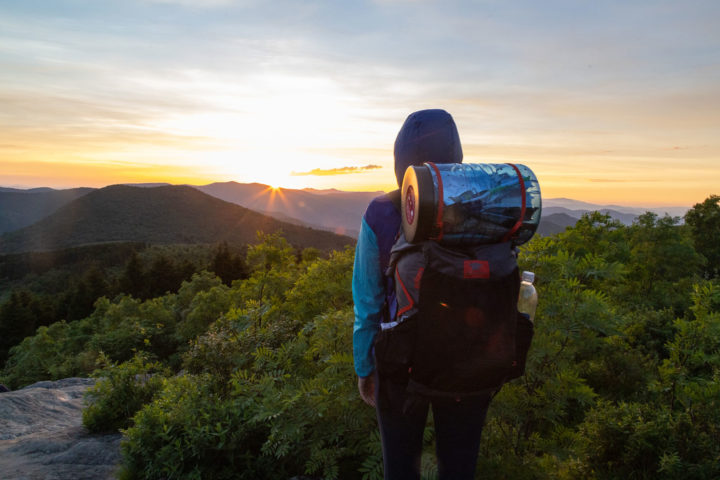by Alivia Acosta, ATC Volunteer Development Coordinator
Protecting Life on the Trail, Large and Small
Visitors to the Appalachian Trail (A.T.) find refuge from a human-made world. This is true, too, for the many animals and plants that benefit from the protection of the Trail by volunteers. While every visitor — hikers and volunteers alike — can support nature by practicing Leave No Trace principles, here are some other specific ways volunteers help creatures large and small.

Save the Bears
Volunteers along the length of the A.T. work to protect mega-fauna, like bears, from the impacts of visitors. In particular, think of the effort needed to haul in a bear-safe food storage box to an overnight site. Volunteers help in other ways, too, by educating visitors as Trail ambassadors or trail patrol volunteers.
Richard Heath decided to join the Potomac Appalachian Trail Club’s (PATC) Trail Patrol program. In this role, he scouts for trail maintenance needs, offers guidance or support for visitors and offers good information on how all visitors can keep wildlife wild by effectively practicing the seven Leave No Trace Principles. The goal of his efforts is to support all life (humans, plants, and animals) to continue to enjoy the Trail in harmony.

Similar to Heath’s efforts with the PATC, volunteers with other clubs are also helping to decrease the chances of hikers accidentally feeding a bear so that bears and humans remain safe. Here are some other visitor education-based roles that help mega-fauna thrive. If you are interested in one of these roles without a dedicated information page, send an email to the respective A.T. Maintaining Club via the information on their webpages.
- Georgia A.T. Club, Trail Ambassador Program (Georgia)
- Nantahala Hiking Club, Trail Ambassador Program (North Carolina)
- Carolina Mountain Club, Max Patch Trail Ambassador Program (North Carolina)
- ATC Damascus Trail Center, Visitor Center Volunteer (Southwest Virginia)
- Roanoke A.T. Club, McAfee Knob Task Force (Central Virginia)
- ATC Harpers Ferry, Visitor Center Volunteer (West Virginia)
Making Places Better for Butterflies, Bees, and Birds
“Garlic Mustard appears, on the surface, to be a pretty, early blooming flower on the edge of the forest — sometimes on the very edge of the Appalachian Trail,” said Barbara Morgan with the Carolina Mountain Club’s Natural Resources Team. “As I learned through cooperative work sessions with staff from the Appalachian Trail Conservancy, this noxious weed hinders necessary biodiversity by blocking sunlight and outcompeting native, beneficial species of plants. Battling Garlic Mustard is a commitment, as it can take five years or more of consistent hand-pulling, bagging, and properly disposing of these plants to hopefully eradicate Garlic Mustard from an area.” Morgan says that she is happy to be the extra “peoplepower” in this challenging and rewarding effort to retain a biodiverse habitat for pollinators.
Farther north, Pipefitters Field in Pennsylvania is an area volunteers have been working to reclaim from the grips of Autumn Olive, an invasive plant species that out-competes the meadow species that nurture in-flight species.
The Appalachian Trail Conservancy (ATC) Volunteer Engagement Platform has opportunities to help protect winged species between April and October. Find these events by filtering “Activity Type” to “Wildlife and Ecosystem Protection.”

Catalog Flora and Fauna on Your Next Walk
The ATC and its management partners benefit from crowdsourced natural resource data collection. Monitor wildlife sightings or plants in various growth stages by adding sightings to the iNaturalist App, attributed to the Flowers and Fauna along the A.T. project. This is an easy and informal way to give back to natural resource management as time allows.

Find an opportunity to volunteer on the A.T. Volunteer Engagement Platform: www.appalachiantrail.org/waystovolunteer
Discover More

BY CAITLIN MILLER
11 Easy Ways to Improve Your Leave No Trace Footprint
A collection of simple and seemingly small ways you can practice Leave No Trace and help protect the A.T. experience.

Roan Highlands Haven
Appalachian Balds are for the Birds
The iconic bald mountains along the Appalachian Trail in North Carolina and Tennessee are significant to the future of migratory and resident birds.

Press Release
ATC Recommends Bear-Resistant Food Storage Containers
This policy comes after a multi-year increase in human-bear encounters at A.T. campsites, many of which were the result of improper food storage by visitors or black bears’ successful circumvention of traditional food storage techniques.
